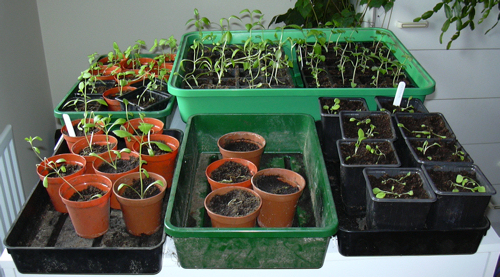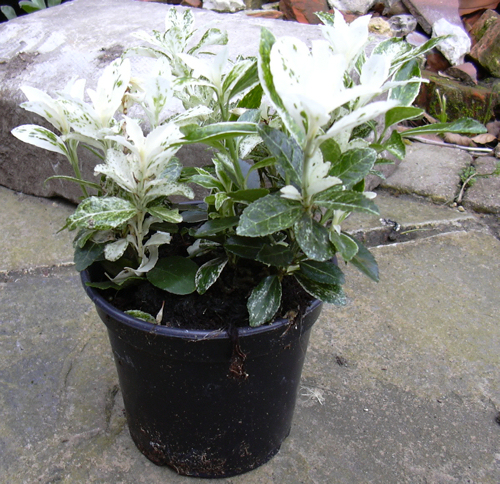Interim results of half hardy seed project
It is now the end of April, and in a month’s time it should be safe to plant my half hardy annuals outside. Avid readers of this blog will recall that last year I sowed some hardy annuals in a patch of ground that I intended to dig up the following autumn. However, slippage on the project meant that the patch of ground did not get dug up after all, and this year I have decided to plant half hardy annuals instead, on the grounds that I can zap the ground with glyphosate to keep the weeds down until the plants are ready to go out, and because they will be quite big when I plant them, they should be able to compete with the new weeds better than the hardy annuals did.
I can now report on the disadvantages of the half hardy annuals strategy. The main one is the difficulty of finding enough places in the house that get enough light to stop the seedlings becoming too spindly. As you can see from the picture, some of mine are a bit straggly. It is possible that they might have grown better if the room had been cooler.
If I had my greenhouse, I could put the plants in there during the day and take them back into the house at night (to save on heating the greenhouse while the nights are still quite cold) and then there wouldn’t be this problem.
However, apart from the light problem, the half hardy annual strategy is quite a good one. The labour involved in pricking out the seedlings is nothing compared to the amount of weeding I had to do last year, and if I had planted the larger seeds (salvia and dahlia) into separate plugs or pots I wouldn’t have had to prick them out yet. I won’t bother trying to grow petunias from seed again, as they are far too weak and feeble.
There is also the small problem that it keeps raining whenever I have any free time to do things in the garden. This means that I haven’t put any glyphosate on the area where the seedlings will be planted yet. However, there is still time to do this.
The problem with light has made me more determined to do everything I can to get the greenhouse installed this winter. The main thing is to install the shed first, so that I can move tools from the garage to the shed, thus releasing space to store the greenhouse when it arrives until the time when I can have it assembled. Unfortunately, the rain has been something of an obstacle to this task. I also need to start renewing the Leylandii hedge with thuja, and I want to dig up the trees that will be behind the greenhouse before the greenhouse is installed, so they don’t fall on the greenhouse.
Last Saturday I happened to go to the library, and Fleet Market was just outside, and I just happened to see some plants that looked nice, so I impulse-bought a dwarf lilac rhododendron and also a euonymus of a type I don’t remember seeing before. The baby leaves of the euonymus are literally pure white, and then they become green and white variegated. I looked on Google Images, and I think it is euonymus fortunei ‘Harlequin’. I have already planted the rhododendron in the border by the side of the house, along with the red one that I got from B&Q two weeks ago, but no, I do not know where I am going to put the euonymus. The rhododendron was £3 and the euonymus was £2. Excellent value.
Apologies for the over-exposure, which is caused by me not being a very good photographer.





